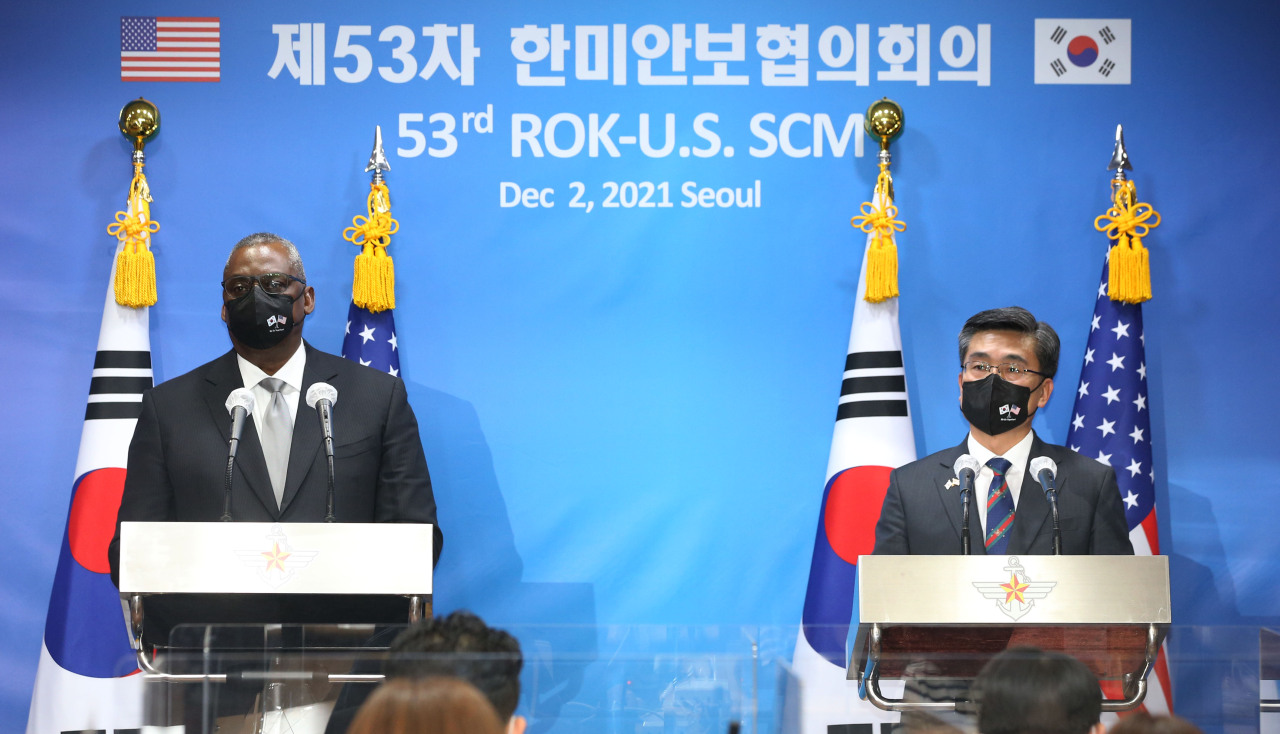South Korean and US defense chiefs on Thursday agreed to update war plans against Pyongyang’s growing missile and nuclear threats and to conduct a long-postponed assessment required for Seoul to regain wartime operational control, or OPCON, next fall.
The announcement comes after South Korea’s Defense Minister Suh Wook and US Defense Secretary Lloyd Austin hosted the 53rd Security Consultative Meeting the same morning in Seoul.
Secretary Austin said Seoul and Washington discussed measures to enhance the US-South Korea “combined deterrence posture and to defend against a full range of threats” at a news conference following the security meeting.
New operational war plans Notably, the defense chiefs approved a new Strategic Planning Guidance, which is the foundation for updating operational plans, the South Korea-US joint statement said.
Seoul and Washington will write new operational war plans reflecting “changes to the strategic environment,” with the aim to “more effectively deter — and as necessary respond to — DPRK threats to the US-ROK Alliance.”
During the news conference, Austin said the approval of the SPG is an “important step forward to frame forthcoming alliance planning,” explaining that both sides shared the assessment that Pyongyang’s advanced missile and nuclear capabilities are “increasingly destabilizing for regional security.”
Thursday’s announcement is significant as South Korea and the US will write new war plans to replace or supplement the current OPLAN 5015 after 11 years.
Seoul and Washington previously agreed on the SPG on developing OPLAN 5015 in 2010 on the occasion of the 42nd SCM. Years later, the operational plan was officially signed by the two countries in 2015.
A three-stage process of devising the new OPLAN will take years. Specifically, the South Korean and US chairman of the Joint Chiefs of Staff will devise the Strategic Planning Directive as a follow-up measure. Then, the South Korea-US Combined Forces Command will write new war plans.
In a closed-door briefing, a South Korean defense official, who wished to remain anonymous, said both sides agreed to announce the fresh SPG after a yearslong consultation, pointing out that Washington suggested updating war plans.
The official added that it is unclear whether the fresh OPLAN will supplant or supplement OPLAN 5015 that has not been updated since 2015. Previously, OPLAN 5015 replaced OPLAN 5027, which was first established in 1974, on the assumption that Seoul would regain wartime OPCON by 2015.
OPCON transfer, FOC assessment
South Korea and the US also decided to conduct the assessment of Seoul’s Full Operational Capability during next year’s Combined Command Post Training in a move to take further steps to transfer wartime operational control to South Korea.
But notably, Seoul and Washington will carry out the test next fall, not during the term of the Moon Jae-in government, which has pledged to complete wartime OPCON transfer by May 2022.
The test is the second stage of assessing the South Korean military’s capabilities to command the future combined defense system in three phases. South Korea and the US completed the first stage in 2019, but the two countries have only conducted a rehearsal for the second stage mainly due to the COVID-19 pandemic.
But South Korea’s defense official said it is too early to predict when Seoul will complete the process of retaking wartime OPCON.
The assessment is only one among three conditions for the wartime OPCON transition as stipulated in the bilaterally agreed transition plan. And the South Korean military should pass the second-stage FOC test to demonstrate core capabilities to lead the combined defense posture.
Indo-Pacific strategy, China challenge, Taiwan
At the security meeting, South Korea and the US committed to developing the alliance “in a mutually reinforcing and future-oriented manner.”
Washington affirmed its commitment to defend South Korea, including the provision of extended nuclear deterrence.
The joint statement restored the clause that reaffirms its commitment to maintaining the current level of personnel of the United States Forces Korea in order to “defend” South Korea. It was previously removed last year under the Trump administration.
Seoul and Washington also notably discussed how the alliance contributes to stability throughout the Indo-Pacific region, although the SCM joint statement did not make direct mention of China.
In the joint statement, “Secretary Austin noted that the Indo-Pacific region is the Department of Defense’s priority theater.”
Specifically, Seoul and Washington committed to promoting military cooperation between the US Indo-Pacific Strategy and South Korea’s New Southern Policy and aligning their regional strategies.
Austin and Suh also reaffirmed the significance of the “rules-based international order and adherence to international rules and norms, including those of freedom of navigation and overflight.”
In the context, the SCM joint communique took note of the “importance of preserving peace and stability in the Taiwan Strait,” echoing the Biden-Moon joint statement in May.
This is the first time that the SCM joint statement makes reference to Taiwan, but the defense official said Suh and Austin did not discuss Taiwan-related issues at the meeting. Nonetheless, it is still noteworthy given that the Moon Jae-in government has maintained its strategic ambiguity amid the growing US-China rivalry.
Thursday’s announcement is in line with the Biden administration’s global posture review, which called for enhancing cooperation with allies and partners in maintaining stability in the Indo-Pacific region and responding to challenges by China and North Korea.
The SCM also comes at a critical juncture as the Biden administration is in the process of drafting key strategy documents including a national security strategy and a nuclear posture review, which is expected to be completed early next year.
By Ji Da-gyum (
dagyumji@heraldcorp.com)








![[Today’s K-pop] Blackpink’s Jennie, Lisa invited to Coachella as solo acts](http://res.heraldm.com/phpwas/restmb_idxmake.php?idx=644&simg=/content/image/2024/11/21/20241121050099_0.jpg)